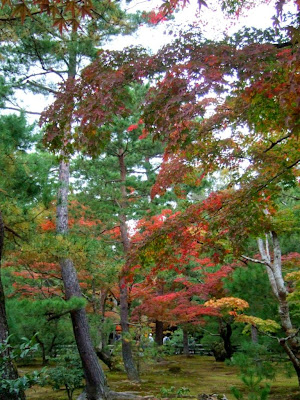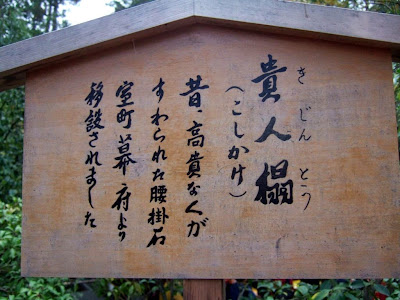
The magnificent Rokuon-ji Zen Temple that commonly known as Kinkaku-ji is the most famous attraction in Kyoto. It was a retirement villa of Shogun Ashikaga Yoshimitsu (1358-1409) constructed in year 1393. As the will of Shogun, the building was converted into a Zen temple after his death. Rokuon-ji reflected the 14th century extravagant Kitayama culture developed in the wealthy aristocratic circles of Kyoto. Through out its entire history, the complex was burnt down several times during in civil wars. The latest happened in 1950 when a fanatic monk set it on fire. The existing glittering image of Golden Pavilion though was only restored in 1955, it is still able to originate a strong impact that exudes a timeless impression.



Kimkaku-ji was listed into Unesco world heritage site in year 1994


The five precepts which are the basic commandments in Buddhism was highlighted on the board at the entrance gate. And under the roof eave was a wooden tablet written under a headline of Sutra of no characters, which if I am not mistaken are referring to the truth of nature that verifies the reality of Dharma without engaging any wordings.


Golden Pavilion is particularly stunning when covered in snow in winter!


The first floor of Golden Pavilion enshrines an image of Shaka Buddha and a portrait of shogun. A seated Kannon image with figures of four heavenly kings are housed in the second floor.


The reflection of gold gilded Temple Pavilion on the water surface was an impressive and striking sight.



Each floor of the Golden Pavilion represents a different style of architectural design. The design of first floor that was used as a palace was based in Shinden style from Heian period of 11th century. The white plastered wall with natural wood columns contrasts yet compliment the gold gilded upper floors. The imperial aristocracy was named as Chamber of Dharma Waters.



The 2nd floor with exterior completely coated in gold foil and decorated with paintings of famous artist Kano, was used as a venue for meeting honored guests. It was addressed as Tower of Sound Waves and was built basing in the style of Bukke that was usually found in samurai residences. The 3rd floor that was designed into a Chinese Zen Hall with a golden phoenix capped at the thatched top was known as Cupola of The Ultimate or Firmament Top. It was gilded with gold leaf internally and externally.


The unfolding view of Kinkaku-ji with reflection in the mirror lake is simply awesome.


The entire grounds were designed into a paradise of Buddhist ultimate world with ponds and inlets that most probably resembled the pool of seven jewels that filled with eight waters of merits and virtue that were mentioned in the Amitabha Sutra.




Luxuriant Kingaku-ji and elegant Kimono ladies are the two symbols of Kyoto.



Beautiful young ladies on Kimono at Kingaku-ji, attract as much attention as the building.


Kyoko-chi is as clear as a mirror and it has ten little islands in it.


The vintage point was mobbed with tourists.














The garden layout design in the complex is an excellent example from Muromachi period (1392-1573). Golden pavilion was set in a magnificent strolling garden extends over a mirror clear pond.



The golden pavilion building is an exact replica of the 14th century structure that was burned down in 1950.



The fishing deck and a small inlet at the rear of Golden Pavilion allows a little boat to moor under it.



Rear view of Golden Pavilion.



The calm Kyoko-chi mirror lake was brightened up with fall foliage.





The path behind the pavilion leads through the entire temple grounds.



Gardens retained the original design from Shogun period in 14th century.






Rocks composition with bridges, plants are set to represent famous places from Chinese and Japanese literature.






The fall of carp rock referring to the Chinese legend about how a river carp after timeless trials, jumped cross over the high gauge to the other side of the water dam and became a dragon ascending to heaven, representing a person attain a great success after being suffering and struggling long time.



The little stone Stupa at Anmintaku pond is said to be the mound built in memory of the mythological white snake from the folktales of Ming Dynasty (1368-1644). She manifested into human being and fell in love with a man but was forced to separate by a monk and finally was suppressed under a pagoda... It was said that water in Anmintaku pond had never been dried up.


Throwing coin for your luck!



The wooded ground at the back of Golden Pavilion.


The golden phoenix ornament standing above the thatched roof of the pavilion can be seen clearly from this angle. Standing within the ground, there is also a small bell pavilion.


A bronze phoenix ornament was placed on top of the shingles at the pyramid shape thatched roof.


The traditional thatched house was a tea house known as Sekka-tei. It was added to the premises in 17th century to honor the visit of Emperor G0-Mizano. The building was burnt down in 1874 and restored in 1884 but the present one was rebuilt recently in 1997. Main purpose of building the structure with simplicity in the past was to make the guests' attention focused on the tea ceremony.



The alcove of the tea house is supported by a crooked pillar made of Nandin, kind of slow growing tree. It is very rare to have a tree growing into this size.



The thatched roof of the tea house is almost half a meter in width.


Its stone lantern, basin and this stone stool are items dated from Hana-no-Gosho Flower Palace in Muromachi period (1392-1573)


The building of chief monk was not opened for public. The little cozy souvenir stall at the exit way was not allowed to take photo (sorry, I took it before I saw the sign). But we were allowed to pay our homage to Fudo-Myoo, one of the five wisdom Dharma protectors enshrined in the small Fudodo Shrine Hall. Buddhist guardian Fudo-Myoo is one of the most important figures in Japan religions history.



Very nice article! I had just share this article on my travel site, I hope you don’t mind. This is a website that let bloggers or travelers to share some great articles or photos about travel, and indexed by attractions.
ReplyDeleteI know you love travel and write a lots of blog post about interesting places in the world, so I would like to invite you to join us and share more of your articles.
You can check the link below to find your articles on my site, if you don’t want me to share your articles, please tell me, I will remove it as soon as possible.
http://www.travelersfootprint.com/en/attraction-detail/kinkaku-ji@Kyoto
Have a great weekend!
Sam
Sorry for this late response as busy in volunteering work for the past year. I am sure many people like me writing blog post on interesting places are to share with people. I certainly would like to join you and share more of my other traveling posts in your website so that more people can admire beautiful parts of the world.
Delete